Animations are not a strictly-defined genre category, but rather a film technique, although they often contain genre-like elements. Animation, fairy tales, and stop-motion films often appeal to children, but it would marginalize animations to view them only as "children's entertainment." Animated films are often directed to, or appeal most to children, but easily can be enjoyed by all. See section on children's-family films. Also see this website's related section on Visual and Special Effects Milestones in Cinematic History as well as AFI's 10 Top 10 - The Top 10 Animated Films.
Early Animation:
The predecessor of early animation was the newspaper comic strips of the 1890s. Historically and technically, the first animated film (in other words, the earliest animated film ever made) was Humorous Phases of Funny Faces (1906) by newspaper cartoonist J. Stuart Blackton, one of the co-founders of the Vitagraph Company. It was the earliest surviving example of an animated film. It was the first cartoon to use the single frame method, and was projected at 20 frames per second. In the film, a cartoonist's line drawings of two faces were 'animated' (or came to life) on a blackboard. The two faces smiled and winked, and the cigar-smoking man blew smoke in the lady's face; also, a circus clown led a small dog to jump through a hoop.
This was soon followed by the first fully-animated film - Emile Cohl's Fantasmagorie (1908, Fr.), which consisted solely of simple line drawings (of a clown-like stick figure) that blended, transformed or fluidly morphed from one image into another.
Winsor McCay ("America's Greatest Cartoonist"):
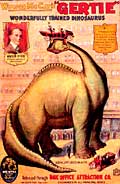 New York Herald comic-strip animator and sketch artist Winsor McCay (1869-1934) produced a string of comic strips from 1904-1911, his three best being Dreams of the Rarebit Fiend, Little Sammy Sneeze, and Little Nemo in Slumberland (from October 15, 1905 to July 23, 1911). Although McCay wasn't the first to create a cartoon animation, he nonetheless helped to define the new industry. He was the first to establish the technical method of animating graphics. His first animation attempt used the popular characters from his comic strip (and became part of his own vaudeville act): Little Nemo in Slumberland (1911) (with 4,000 hand-drawn frames), followed by How a Mosquito Operates (1912) (with 6,000 frames).
New York Herald comic-strip animator and sketch artist Winsor McCay (1869-1934) produced a string of comic strips from 1904-1911, his three best being Dreams of the Rarebit Fiend, Little Sammy Sneeze, and Little Nemo in Slumberland (from October 15, 1905 to July 23, 1911). Although McCay wasn't the first to create a cartoon animation, he nonetheless helped to define the new industry. He was the first to establish the technical method of animating graphics. His first animation attempt used the popular characters from his comic strip (and became part of his own vaudeville act): Little Nemo in Slumberland (1911) (with 4,000 hand-drawn frames), followed by How a Mosquito Operates (1912) (with 6,000 frames).
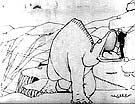 His first prominent, successful and realistic cartoon character or star was a brontosaurus named Gertie in Gertie the Dinosaur (1914) (with 10,000 drawings, backgrounds included), again presented as part of his act. In fact, McCay created the "interactive" illusion of walking into the animation by first disappearing behind the screen, reappearing on-screen!, stepping on Gertie's mouth, and then climbing onto Gertie's back for a ride - an astonishing feat! It was the earliest example of combined 'live action' and animation, and the first "interactive" animated cartoon. Some consider it the first successful, fully animated cartoon - it premiered in February 1914 at the Palace Theatre in Chicago.
His first prominent, successful and realistic cartoon character or star was a brontosaurus named Gertie in Gertie the Dinosaur (1914) (with 10,000 drawings, backgrounds included), again presented as part of his act. In fact, McCay created the "interactive" illusion of walking into the animation by first disappearing behind the screen, reappearing on-screen!, stepping on Gertie's mouth, and then climbing onto Gertie's back for a ride - an astonishing feat! It was the earliest example of combined 'live action' and animation, and the first "interactive" animated cartoon. Some consider it the first successful, fully animated cartoon - it premiered in February 1914 at the Palace Theatre in Chicago.
McCay's 12-minute propagandistic, documentary-style The Sinking of the Lusitania (1918), an animation landmark, was the first serious re-enactment of an historical event - the torpedoing of the RMS Lusitania by a German U-boat on May 7, 1915, resulting in the loss of almost 2,000 passengers. It was one of the earliest films to utilize cel animation.
Soviet animator (W)ladislaw Starewicz created the first 3-D, stop-motion narratives in two early films with animated insects: The Grasshopper and the Ant (1911) and The Cameraman's Revenge (1911). And John Randolph Bray's first animated film, The Artist's Dream(s) (1913) (aka The Dachshund and the Sausage), the first animated cartoon made in the U.S. by modern techniques was the first to use 'cels' - transparent drawings laid over a fixed background.
Felix the Cat: First Appearance in 1919
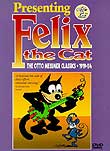 The first animated character that attained superstar status (and was anthropomorphic) during the silent era was the mischievous Felix the Cat, in Pat Sullivan Studios. He was inspired by Kipling's The Cat That Walked By Himself in the Just So Stories published in 1902.
The first animated character that attained superstar status (and was anthropomorphic) during the silent era was the mischievous Felix the Cat, in Pat Sullivan Studios. He was inspired by Kipling's The Cat That Walked By Himself in the Just So Stories published in 1902.
Originated by young animator Otto Messmer, the (unnamed) cat's first two cartoons were the five-minute Feline Follies (1919) and Musical Mews (1919), when Felix was known only as "Master Tom." Feline Follies was a segment of the Paramount Magazine, a semi-weekly compilation of short film segments that included animated cartoons. By the third Felix cartoon, The Adventures of Felix (1919), Felix took his permanent name. For the first few years, the Felix cartoons were distributed by Paramount Pictures, and then by M.J. Winkler. Messmer directed and animated more than 175 Felix cartoons in the years 1919 through 1929. Felix was the first character to be widely merchandised. The last Felix the Cat cartoon, The Last Life (1928), was due to the advent of the talkies and the success of Walt Disney's Mickey Mouse. Messmer continued with his comic strip (begun in 1923) until 1966.
First Color Cartoon:
Producer John Randolph Bray's (and Bray Picture Corporation's) The Debut of Thomas Cat (1920) has often been credited as the first color cartoon, using the expensive Brewster Natural Color Process (a 2-emulsion color process), an unsuccessful precursor of Technicolor. This was the first animated short genuinely made in color using color film. Drawings were made on transparent celluloid and painted on the reverse, then photographed with a two-color camera. However, some sources have claimed that the Natural Colour Kinematograph Company's In Gollywog Land (1912, UK) was the earliest, using Kinemacolor.
First Animated Feature:
The little-known but pioneering, oldest-surviving feature-length animated film that can be verified (with silhouette animation techniques and color tinting) was released by German film-maker and avante-garde artist Lotte Reiniger, The Adventures of Prince Achmed (aka Die Abenteuer des Prinzen Achmed) (1926, Germ.), based on the stories from the Arabian Nights. Reiniger's achievement is often brushed aside, due to the fact that the animations were silhouetted, used paper cut-outs, and they were done in Germany. And the rarely-seen prints that exist have lost much of their original quality. However, the film was very innovative -- it used multi-plane camera techniques and experimented with wax and sand on the film stock.
Early Walt Disney:
A classic animator in the early days of cinema was Walt Disney, originally an advertising cartoonist at the Kansas City Film Ad Company, who initially experimented with combining animated and live-action films. The very first films he made himself at his own animation studio in Kansas City were short cartoons called Newman Laugh-O-Grams, such as Little Red Riding Hood (1922) - the first Walt Disney cartoon, and the Four Musicians of Bremen (1922).
His first successful silent cartoons (from 1923-1927), after relocating and setting up his own studio in Los Angeles (the Disney Brothers Studio) were a series of shorts (56 episodes) called Alice Comedies (or Alice in Cartoonland) that debuted in 1924 with Alice's Day at Sea (1924). Disney's Alice cartoons placed a live-action title character (Alice) into an animated Wonderland world. Soon after, Oswald the Lucky Rabbit became Disney's first successful animal star in a 26-cartoon series distributed by Universal beginning in 1927. Oswald was the first Disney character to be merchandized. Oswald appeared in a number of cartoon shorts, such as: Trolley Troubles (1927) and Poor Papa (1927). Disney produced about two dozen of the silent, black and white Oswald cartoons from 1927-1928 until forced to give up the character to Walter Lantz. He moved onto another memorable character - first named Mortimer Mouse - or Mickey Mouse (looking like Oswald with his ears cut off) in 1928.
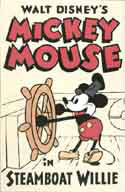 The Debut of Mickey Mouse:
The Debut of Mickey Mouse:
In 1928, Disney Studios' chief animator Ub Iwerks (1901-1971) developed a new character from a figure known as Mortimer Mouse, a crudely-drawn or sketched, rodent-like 'Mickey Mouse' - slightly similar to Felix the Cat. [Mickey Mouse was never a comic strip character before he became a cartoon star.] The first Mickey Mouse cartoon was released on May 15, 1928: Plane Crazy (1928) in which Mickey, while impressing Minnie, imitated aviator Charles Lindbergh. The second was Steamboat Willie (1928), first released (on a limited basis) on July 29, 1928, with Mickey as a roustabout on Pegleg Pete's river steamer, but without his trademark white gloves. The third was The Gallopin' Gaucho (1928) released on August 2, 1928. (These early films were soon re-worked and re-released with sound - with electrifying results.)
 To help make Mickey stand out from other cartoon characters at the dawn of the talkies, the 7-minute Steamboat Willie (1928) was re-released on November 18, 1928 with sound and premiered at the 79th Street Colony Theatre in New York - it was the first cartoon with post-produced synchronized soundtrack (of music, dialogue, and sound effects) and is considered Mickey Mouse's screen debut performance and birthdate. Animated star Mickey (with Minnie) was redrawn with shoes and white, four-fingered gloves. [The character was a take-off based upon Buster Keaton's Steamboat Bill (1928). ] It was a landmark film and a big hit - the first sound cartoon to be a major hit - leading to many more Mickey Mouse films during the late 1920s and 1930s. Strangely, Mickey's first sound cartoon didn't include Mickey's voice -- he didn't speak until his ninth short, The Karnival Kid (1929) when he said the words: "Hot dogs!" [Walt's voice was used for Mickey.] Walt Disney was fast becoming the most influential pioneer in the field of character-based cel animation, through his shrewd oversight of production.
To help make Mickey stand out from other cartoon characters at the dawn of the talkies, the 7-minute Steamboat Willie (1928) was re-released on November 18, 1928 with sound and premiered at the 79th Street Colony Theatre in New York - it was the first cartoon with post-produced synchronized soundtrack (of music, dialogue, and sound effects) and is considered Mickey Mouse's screen debut performance and birthdate. Animated star Mickey (with Minnie) was redrawn with shoes and white, four-fingered gloves. [The character was a take-off based upon Buster Keaton's Steamboat Bill (1928). ] It was a landmark film and a big hit - the first sound cartoon to be a major hit - leading to many more Mickey Mouse films during the late 1920s and 1930s. Strangely, Mickey's first sound cartoon didn't include Mickey's voice -- he didn't speak until his ninth short, The Karnival Kid (1929) when he said the words: "Hot dogs!" [Walt's voice was used for Mickey.] Walt Disney was fast becoming the most influential pioneer in the field of character-based cel animation, through his shrewd oversight of production.
The Fleischer Brothers: Inventors, Cartoon Makers
At the same time, serious rivals to Disney's animation production came from the Fleischers (Max, Dave, Joe, and Lou). They were already making technical innovations that would revolutionize the art of animation. In 1917, Max Fleischer invented the rotoscope to streamline the frame-by-frame copying process - it was a device used to overlay drawings on live-action film. The Fleischers were also pioneering the use of 3-D animation landscapes, and produced the hour-long Einstein's Theory of Relativity (1923), the first feature animation (a documentary).
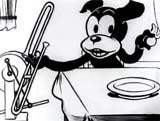 The Fleischer Brothers also made the first animated films (cartoons) that featured a soundtrack, in a series of 36 films released in the mid-1920s called Ko-Ko Song Car-Tunes (1924-1927) - the precursors to karaoke. The first sound cartoon was one of the Song Car-Tunes -- Mother Pin a Rose on Me. They were also the first audience participation films, with sing-along lyrics and a 'bouncing-ball' helper. They included Has Anybody Here Seen Kelly? (1926), When The Midnight Choo-Choo Leaves For Alabam' (1926), Comin' Tho' The Rye (1926), Margie (1926), My Old Kentucky Home (1926), Tramp, Tramp, Tramp-The Boys Are Marching (1927), By The Light Of The Silvery Moon (1927). In My Old Kentucky Home, Bimbo said to the audience: “Follow the ball and join in everybody." Twelve of the 36 short films were released in both sound and silent versions.
The Fleischer Brothers also made the first animated films (cartoons) that featured a soundtrack, in a series of 36 films released in the mid-1920s called Ko-Ko Song Car-Tunes (1924-1927) - the precursors to karaoke. The first sound cartoon was one of the Song Car-Tunes -- Mother Pin a Rose on Me. They were also the first audience participation films, with sing-along lyrics and a 'bouncing-ball' helper. They included Has Anybody Here Seen Kelly? (1926), When The Midnight Choo-Choo Leaves For Alabam' (1926), Comin' Tho' The Rye (1926), Margie (1926), My Old Kentucky Home (1926), Tramp, Tramp, Tramp-The Boys Are Marching (1927), By The Light Of The Silvery Moon (1927). In My Old Kentucky Home, Bimbo said to the audience: “Follow the ball and join in everybody." Twelve of the 36 short films were released in both sound and silent versions.
[Little-known fact: Max Fleischer was the father of Richard Fleischer, the director of Disney's 20,000 Leagues Under the Sea (1954), Fantastic Voyage (1966), Doctor Dolittle (1967) and Soylent Green (1973).]
- Ko-Ko the Clown
One of the Fleischers' first successful ventures occurred in 1919 with the premiere of the part live-action/part animation Out of the Inkwell series of shorts, featuring the animated Ko-Ko the Clown character in a live-action world - one of the first animated characters. Ko-Ko climbed out of the inkwell and interacted with the human animator.
 Bimbo
Bimbo From 1929-1932, their Talkartoons for Paramount starred a mouse-like character named Bimbo - who was soon relegated to a minor companion co-star with the Fleischer's next racy cartoon star.
- Betty Boop
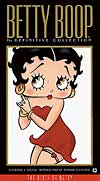 Max Fleischer was responsible for the provocative, adult-oriented, cartoon Betty Boop vamp-character, who always wore a strapless, thigh-high gown (and visible garter) and was based on flapper icon Clara Bow's 'It' Girl and Mae West. A prototype of the squeaky- and baby-voiced cartoon queen (voiced for most of the 30s by Mae Questel) was introduced in a Bimbo Talkartoon entitled Dizzy Dishes (1930) - with her appearing as a long-eared puppy dog! In the early cartoon Betty Co-Ed (1931), she was called Betty, and in a pre-Code Bimbo cartoon entitled Silly Scandals (1931) (the title spoofed Disney's Silly Symphonies), she was named Betty Boop for the first time (she sings You're Driving Me Crazy while her dress top keeps falling down). However, in Stopping the Show (1932), she appeared under her own credits banner for the first time (she had previously appeared only in Talkartoons and Screen Songs).
Max Fleischer was responsible for the provocative, adult-oriented, cartoon Betty Boop vamp-character, who always wore a strapless, thigh-high gown (and visible garter) and was based on flapper icon Clara Bow's 'It' Girl and Mae West. A prototype of the squeaky- and baby-voiced cartoon queen (voiced for most of the 30s by Mae Questel) was introduced in a Bimbo Talkartoon entitled Dizzy Dishes (1930) - with her appearing as a long-eared puppy dog! In the early cartoon Betty Co-Ed (1931), she was called Betty, and in a pre-Code Bimbo cartoon entitled Silly Scandals (1931) (the title spoofed Disney's Silly Symphonies), she was named Betty Boop for the first time (she sings You're Driving Me Crazy while her dress top keeps falling down). However, in Stopping the Show (1932), she appeared under her own credits banner for the first time (she had previously appeared only in Talkartoons and Screen Songs). Betty Boop's voice was actually modeled on the voice of another actress, Helen Kane, who created a sensation on Broadway in 1928 with a "boop-oop-a-doop" rendition of the hit song I Wanna Be Loved by You. The cartoon character with a high baby voice and spit curls then appeared in a series of short cartoons and became the top Fleischer star, in Minnie the Moocher (1932), the risque Boop-Oop-A-Doop (1932), Betty Boop's Bamboo Isle (1932), the five-minute Snow White (1933) (with an appearance by Cab Calloway) - the first animated film based upon the Grimm Brothers' fairy tale, Betty Boop's Rise to Fame (1934), in her sole color cartoon Poor Cinderella (1934) - the Fleischer's first color cartoon with Betty sporting red hair, and Riding the Rails (1938). She displayed a bit of breast and performed a sexy hula in the pre-code Betty Boop's Rise To Fame (1934). Unfortunately, the cute, titillating 'boop-oop-a-doop' Betty was destined to be censored with the advent of the enforceable, conservative and puritanical Hays Production Code in 1934. Drastic changes to her character after 1934 led to her demise by 1939, with her last cartoon, Yip Yip Yippy (1939). [During the 30s, Mae Questel recorded On the Good Ship Lollipop -- in Betty Boop's voice-- which sold more than 2 million copies.]
- Popeye
 The Fleischers also obtained the rights to the tough, one-eyed, spinach-loving sailor Popeye with over-sized arms (who was introduced in January 1929 in creator Elzie C. Segar's "Thimble Theatre" newspaper comic strip published in the New York Journal for King Features Syndicate since 1919). Popeye became so popular in the comic strip that it was renamed "Thimble Theatre, Starring Popeye." Popeye first appeared on film alongside established cartoon-star Betty Boop in July, 1933 in Fleischers' Betty Boop cartoon titled Popeye the Sailor (1933), in which they dance the hula. Popeye's voice was provided by William Costello (better known as Red Pepper Sam) from 1933-35. [After Costello was dismissed, Jack Mercer, who began his career as an artist at the cartoon studio, provided Popeye's voice and ad-libbed mutterings for the Fleischers until 1957, and various voices for the two Fleischer feature-length animations - see below.] The same year in September, the first official Popeye cartoon, I Yam What I Yam was released - the first in a long series of animated shorts. Popeye's first Technicolor cartoon was the two-reel special release Popeye the Sailor Meets Sindbad the Sailor (1936), noted for its experimental multi-plane 3-D backgrounds, and for being the first Fleischer cartoon to be nominated for an Academy Award - Best Short Subject - Cartoon. The cartoon character became well-known for his theme song (excerpt below):
The Fleischers also obtained the rights to the tough, one-eyed, spinach-loving sailor Popeye with over-sized arms (who was introduced in January 1929 in creator Elzie C. Segar's "Thimble Theatre" newspaper comic strip published in the New York Journal for King Features Syndicate since 1919). Popeye became so popular in the comic strip that it was renamed "Thimble Theatre, Starring Popeye." Popeye first appeared on film alongside established cartoon-star Betty Boop in July, 1933 in Fleischers' Betty Boop cartoon titled Popeye the Sailor (1933), in which they dance the hula. Popeye's voice was provided by William Costello (better known as Red Pepper Sam) from 1933-35. [After Costello was dismissed, Jack Mercer, who began his career as an artist at the cartoon studio, provided Popeye's voice and ad-libbed mutterings for the Fleischers until 1957, and various voices for the two Fleischer feature-length animations - see below.] The same year in September, the first official Popeye cartoon, I Yam What I Yam was released - the first in a long series of animated shorts. Popeye's first Technicolor cartoon was the two-reel special release Popeye the Sailor Meets Sindbad the Sailor (1936), noted for its experimental multi-plane 3-D backgrounds, and for being the first Fleischer cartoon to be nominated for an Academy Award - Best Short Subject - Cartoon. The cartoon character became well-known for his theme song (excerpt below):
I'm Popeye the Sailor Man
I'm Popeye the Sailor Man
I'm strong to the finich
'Cause I eats me spinach
I'm Popeye the Sailor Man...The voices of Olive Oyl, Popeye's whiny girlfriend, and Sweet Pea were provided by Mae Questel. The character Wimpy provided the name for an unpopular type of British hamburger. By 1938, Popeye had replaced Mickey Mouse as the most popular cartoon character in America. Paramount's Famous Studios continued the series beginning in 1942, and Popeye's movie career lasted until 1957. Robert Altman directed the live-action film flop, Popeye (1980), starring Robin Williams as Popeye, Shelley Duvall as Olive Oyl, and Ray Walston as Pappy, Popeye's father.
- Superman
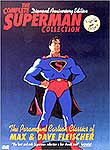 Dave and Max Fleischer, in an agreement with Paramount and DC Comics, also produced a series of seventeen Superman cartoons in the early 1940s. The first Superman short, Superman (1941), premiered in 1941, introduced the terms "faster than a speeding bullet" and "Look, up in the sky!". The most famous of the series was the second entry, The Mechanical Monsters (1941) with the super-hero battling giant flying robots - and marking a redesigned Lois Lane and the first time Superman would change into his costume in a phonebooth. Also notable was The Bulleteers (1942).
Dave and Max Fleischer, in an agreement with Paramount and DC Comics, also produced a series of seventeen Superman cartoons in the early 1940s. The first Superman short, Superman (1941), premiered in 1941, introduced the terms "faster than a speeding bullet" and "Look, up in the sky!". The most famous of the series was the second entry, The Mechanical Monsters (1941) with the super-hero battling giant flying robots - and marking a redesigned Lois Lane and the first time Superman would change into his costume in a phonebooth. Also notable was The Bulleteers (1942).
The Fleischers were responsible for the first ten Superman cartoons (up through Japoteurs (1942)), with the remaining shorts produced by Paramount's Famous Studios during 1942-43. [The recognizable theme song for the series was incorporated into John Williams' score for Superman: The Movie (1978), and the cartoons were referenced in The Iron Giant (1999).]
Fleischer Studios' Two Feature Films:
Two feature-length animations with whimsical characters and advanced animation techniques by the Fleischers deserve mention, although the Fleischers are better-remembered for their shorts than for their only two features:
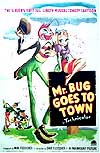 Gulliver's Travels (1939), an animated musical adaptation of Jonathan Swift's 1726 classic literary satire about war. The Fleischers, who were in direct competition with Disney, released this inferior attempt - it was the second American feature-length animated film ever, following (and patterned) after Disney's Snow White and the Seven Dwarfs (1937). (See below) The film was a two-time Academy Awards nominee: for Victor Young's Best Original Score, and for Best Song: Faithful Forever.
Gulliver's Travels (1939), an animated musical adaptation of Jonathan Swift's 1726 classic literary satire about war. The Fleischers, who were in direct competition with Disney, released this inferior attempt - it was the second American feature-length animated film ever, following (and patterned) after Disney's Snow White and the Seven Dwarfs (1937). (See below) The film was a two-time Academy Awards nominee: for Victor Young's Best Original Score, and for Best Song: Faithful Forever. - the expensive, Technicolored Mr. Bug Goes to Town (1941), advertised as the screen's first full-length musical comedy cartoon. (It was originally named after Frank Capra's earlier feature Mr. Deeds Goes to Town (1936), and also given an alternate title: Hoppity Goes to Town.) Due to the film's financial failure, it was the last cartoon feature that Max and Dave released.
As a final footnote, Fleischer Studios, after restructuring as Famous Studios by Paramount, also produced cartoons based on Harvey Comics characters, including over two dozen Little Lulu (Moppet) cartoons in the 40s, and over 50 Casper the Friendly Ghost cartoons that stretched into the 1950s (Casper made his debut in Izzy Sparber's cartoon short The Friendly Ghost (1945)).
No comments:
Post a Comment